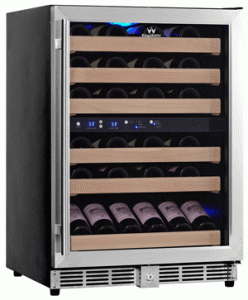There is nothing worse – in wine terms – than being offered a glass of incredible red wine only to swirl, sniff, sip, and realize it’s warm. It happens all the time in restaurants when wine is kept out on the bar, or poured into glassware that just came out of a dishwasher. The wine gets warm and instantly becomes underwhelming. You just overpaid for a glass of warm alcoholic grape juice that better resembles thin cough syrup rather than the wine you saw on the menu.
On the flip side, some overcompensate and keep their white wines way too cold. They think on a hot day, your white wine should be near freezing to offer relief from the heat. That's just wrong. Extreme cold destroys the subtle nature and flavors of a delicate white wine. Why not just have ice water?
 Don’t let these things happen to your wine, and definitely don't let them happen to the wine you pour for your guests. Different wines are meant to be served at different temperatures to allow for development and proper expression of character. After all, there’s a reason why some wine coolers come in dual-zone options.
Don’t let these things happen to your wine, and definitely don't let them happen to the wine you pour for your guests. Different wines are meant to be served at different temperatures to allow for development and proper expression of character. After all, there’s a reason why some wine coolers come in dual-zone options.
Proper serving temperatures for different wines
Light, dry, and crisp white wines, like rosé, Sauvignon Blanc, Pinot Gris, or sparkling wines should be served at 40 to 50 degrees to preserve their freshness and fruitiness. This temperature is also good for sweeter and dessert white wines like Muscadet, Rieslings, or Sauternes to preserve balance and mute sweetness.
Full-bodied white wines, like Chardonnay, and light, fruity reds, like Beaujolais, Gamay, and Old-World Pinot Noir should be served at 50 to 60 degrees to allow for proper exploration of aromas and refreshing complexity of tastes.
Full-bodied red wines, like your favorite Cabernet or Syrah, and dessert reds and Ports should be served at 60 to 65 degrees, still cooler than any room temperature, but warmer than cellar temps. The slightly warmer temperatures allow bitterness from tannins to fade a bit and the wine's more subtle elements to become more pronounced.
How to do it right
Your best case scenario is to take your more precious bottles out of your 55 degrees cellar or wine fridge and put them in your specialty cooler in the kitchen that holds at 65 degrees to gently bring your reds up to your desired serving temperature. Can’t do that? Well, then simply pull the red out of the cellar and let it rest on the counter for about 30 minutes.
Need a quick cool down for your white wines? Immerse the bottle in an ice water bath. Adding water allows more of the bottle to come into contact with the cold than just ice alone, speeding the chill. Put your bottle in the bath, give a few spins, and let it sit for 10 minutes. Believe it or not, that will chill them faster and more uniformly than putting it in the freezer for 15 minutes. If it’s too cold, like the red, you can take a white wine out of the fridge and let it sit for 10 minutes to warm just slightly before serving. Remember, also, that wine will warm in the glass and in the hands of your guests.
If you’ve kept the perfect wine for the perfect situation, don’t blow it at the last minute by serving it too warm or too cold. Serving the proper wine at the proper temperature is just as important as storing it at proper temperature, and is key to getting the most out of the experience.
The following article was provided by our contributing partner — KingsBottle.com.
Cheers — Ken
